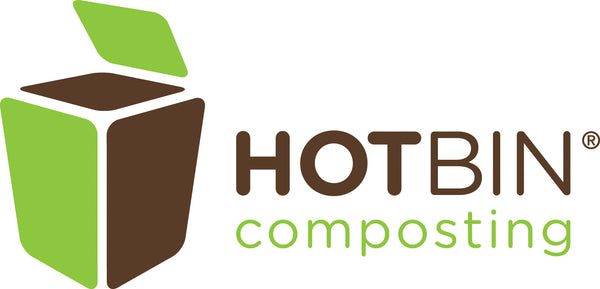How to Compost Grass Quickly and Efficiently with HOTBIN
Composting grass and lawn mowing’s in the HOTBIN decompose quickly, producing a heat boost that helps raise the temperature inside of your HOTBIN. For this reason, it is an excellent material to include, alongside a mixture of other waste types, when starting your HOTBIN and getting it up to 140°F. You can find more information on how to fast-start your HOTBIN Composting journey here.
Grass/lawn mowing’s are a paradox. On one hand it is one of the easiest materials to compost; and on the other hand, in traditional heaps, it is one of the most troublesome materials to compost, producing a lo of heat and a distinctive odor (ammonia/urine) before collapsing into a wet slimy black mess.
Grass and Odor. Grass has an excess of nitrogen that bacterial is unable to use as fast as it is released, forming an ammonia gas odor as it evaporates away during the composting process. You are most likely to notice this odor when composting and/or turning large quantities of 1–2-day old grass lawn mowings. However, after a few days, things slow down, and the odor will disappear as the nitrogen is consumed.
The HOTBIN does have an internal (on lid) charcoal filter that removes the ammonia odor. However, it will require not to add big quantities of grass alone and/or all at once without mixing the load with different types of waste. Adding big quantities of grass only, can temporary overload the carbon filter, releasing some odors during the first 2-3 days of intense bacteria activity.
To help control during the initial 2-3 days, you need to:
- Balance the carbon/nitrogen ratio of the grass with plenty of dry, easy to digest carbon waste. Add corrugated cardboard or shredded paper (ratio of 1:2) to control moisture levels and woody material (ratio of 1:5) for aeration – use wood-chips or twiggy material but avoid sawdust or wood shavings as this can restrict airflow.
or - Add grass in batches and mix it with your regular food and garden waste along with the required ratios of shredded paper/card and woody material..
Grass/lawn mowing’s have a high-water content (>80%) and are low in lignin (i.e., no woody stalk). As grass decomposes, the cells breakdown, become soft and release liquid which results in the grass collapsing into thick layers which reduce airflow and turn the heap anaerobic and produce 'black slime'.
Thankfully 'black slime' is a rarity in the HOTBIN. The excess water is removed as steam when hot composting and ensuring good airflow in the HOTBIN is a breeze.
Adding Grass into the HOTBIN
It is important to note that the HOTBIN works best with a mixture of waste types, so try not to add large quantities of grass alone and all at once without mixing the load with different types of waste. The HOTBIN includes a lid-based charcoal filter that removes the ammonia odor, however solely adding large quantities of grass can temporarily overload the carbon filter, resulting in a whiff of ammonia during those first 2-3 days of intense bacteria activity.
To summarize...
You can compost small and large amounts of grass in the HOTBIN however management of the pile is key to avoid excessive odor and anaerobic heaps.
Is it worth it? Yes! Grass is nitrogen-rich and helps produce great compost and lots of it! Here are some points to take into consideration when composting grass with a HOTBIN:
- Small to medium lawns
Remember to mix in the following materials for good aeration and moisture control:
- Bulking agent (wood-chips) - Add 4 parts bulking agent (wood-chips) to 20 parts grass cuttings (1:5). NB: A typical grass box of 10 gals will need 2 gals. of bulking agent.
- Paper - Add 2 parts grass to one part paper/cardboard (1:2)
NB: A typical grass box of 10 gals will need 5 gals of paper/card.
Alternatively, if you feel that 10 gals of grass is too much and producing too much odor then add half the amount of grass and store the other until 2/3 days later.
Remember the first few cuts in spring tend to generate 2-3 times the volume of grass as later cuts, so you may well have to adjust with the season.
- Large lawns
If you have a large lawn it will cope with 2-4 boxes (about 15-21 gals.) per week. The same rules apply - although adding and mixing in large amounts of paper can be intensive, you will reap the rewards in rich homemade compost!
- Top Tips
- Once grass has been added in, check after a week, and look inside the HOTBIN. If there are any matted grass layers break these up with the rake to maintain airflow, but you do not need to mix with material underneath.
- When adding grass, try to add a mixture of waste types (easy and hard to digest) to ensure the constant production of heat.
- Pre-mix paper/card, wood chips and grass in a big tub, this can really help take the strain when adding the materials into the HOTBIN.
- If you are struggling with wood chips, aeration can be achieved also by adding in woody twig matter from the garden such as woody shrub prunings.

